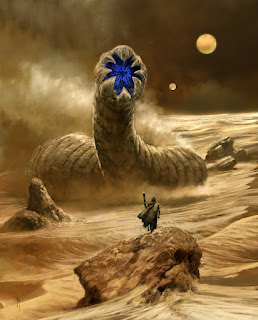Tremors in the sand and water
The giant worms that inhabit Asia
Surely you have seen the famous 1990 film "Terror Under the Earth" and its sequels, if so, you will remember the huge and horrendous creatures that kill several people in the Nevada desert and attack the protagonists of this film, well, although not in Nevada, these horrible beings had an inspiration in a possible real animal, come with me to see the cases of the giant worms of India and Mongolia, thanks for reading, I hope you support this and want to follow me, you would do me a favor by sharing, now without further ado, let's start.
The giant indus worm
In india, also called skōlex, it is a creature mentioned in greek and indian texts, supposedly being a giant worm, white and carnivorous with a large pair of teeth that lived in the Indus River.
This was described as the only creature that inhabits the Indus, and resembled the worm that infested figs, but it had an average of just over 3 meters long, having a pair of large teeth, one in the upper jaw and another in the lower jaw, as the teeth were square, midiendo 1 pygōn on the ancient Greek length scale, about 39 centimeters long in our terms, digging burrows in the mud bottom during the day and devouring nocturnal prey such as horses, cows, donkeys or camels.
This was revered by several Greek philosophers, historians also affirm that the worm was hunted with bait, being dried on poles, Extracting from it a corrosive and flammable oil, being extremely volatile, this oil was used in war by the Indian kings; The cities were set on fire with sealed vessels filled with oil, thrown like grenades, although skeptics believe that the "skolex oil" it may have actually been petroleum or naphtha, and not derived from an animal at all.
Almost all references to its existence come from historical writings, so there are doubts about its existence, some assuming that the skolex referred to some crocodile, Since oil can be extracted from this reptile, it is also known that fish oils or Gangetic dolphin oil have been exploited in India, although not for incendiary purposes, but anyway, there is also a second creature, which casts more doubt on the existence of this being, which we will see right now.
Giant gobi worm
Known in the Mongolian language as олгой-хорхой, it is an invertebrate creature that inhabited or inhabited the Gobi Desert, between China and Mongolia, being first described by Professor Roy Chapman Andrews in his book On the Trail of Ancient Man in 1926.
Described as a huge worm, according to the local population, measuring between 0.6 and 1.5 meters long, shaped like an intestine and reddish brown, accused of being a deadly predator, since it reportedly has a powerful poison capable of killing any living being in a short time, Its skin is supposedly as corrosive as the poison it ejects, since according to anyone who touches it for too long it can end up dead, in addition to being able to generate electric shocks and generate electricity, among other horrendous and partly exaggerated qualities.
There is also a supposed photo of a supposedly stuffed specimen in a private collection, here it is:
There have been multiple reports and investigations by serious institutions, most without success, although Much evidence has been collected from the Gobi explorations of the Chinese side and the Mongolian side, this added to the isolation of Mongolia and government policies have closed the study of its fauna to foreign zoologists, so we know very little about this creature, Although if it exists it is obvious that we could reach the conclusion that both the Indus worm and the Gobi are from the same family, although there have not been any more reports of the Indus worm for a long time, so this is sure to be extinct, we do not support any cryptozoological ideas or theories outside the zoological discipline, I leave it here to your discretion.
[Reading Links]
https://mn.m.wikipedia.org/wiki/%D0%9E%D0%BB%D0%B3%D0%BE%D0%B9_%D1%85%D0%BE%D1%80%D1%85%D0%BE%D0%B9
https://tt.m.wikipedia.org/wiki/%D0%9E%D0%BB%D0%B3%D0%BE%D0%B9-%D1%85%D0%BE%D1%80%D1%85%D0%BE%D0%B9
https://en.m.wikipedia.org/wiki/Indus_worm
https://hi.m.wikipedia.org/wiki/%E0%A4%B8%E0%A4%BF%E0%A4%A8%E0%A5%8D%E0%A4%A7%E0%A5%81_%E0%A4%A8%E0%A4%A6%E0%A5%80







Comments
Post a Comment